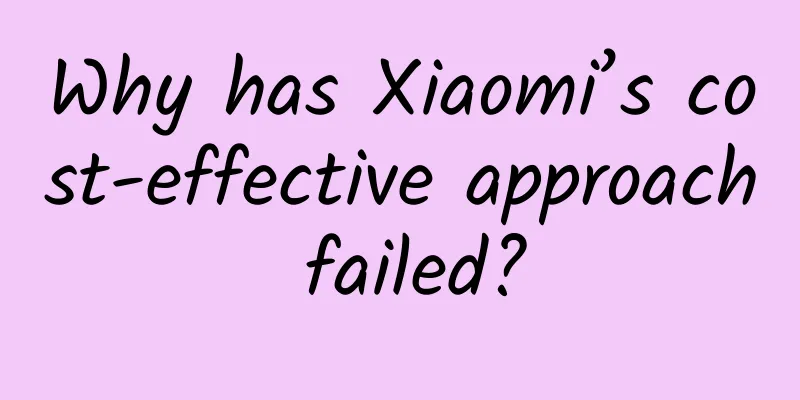Why has Xiaomi’s cost-effective approach failed?

|
In the automobile industry, there is an interesting Suzuki phenomenon, that is, after Suzuki knocks on the door of emerging markets, it will be squeezed out of the mainstream market in the subsequent consumption upgrade. This is mainly because Suzuki focuses on small cars, pays attention to cost-effectiveness and durability, but after all, there are no high-end products, and there is no upward tension in product strength. Once the market opens up, Suzuki has completed its mission and has become a former wave that died on the beach and can only retreat to the outside. At present, Xiaomi seems to have encountered similar problems to Suzuki. After Xiaomi popularized smartphones with low prices, it was almost like a dying wave on the beach, especially in 2016 when it experienced a 36% decline, which shocked everyone. In that year, Samsung's sales plummeted by 50% due to the Note 7 incident, giving up more than 20 million market space. Xiaomi not only failed to catch this opportunity, but also fell into the pit. Instead, Huawei, which continued to strive for high-end products, led the market with the P9/Mate 9, and OV also made efforts offline, pushing Xiaomi, the top player in 2015, to fourth place. Xiaomi's price-performance ratio did not help, but instead exposed its simplicity of technology and the weakness of its channels and supply chain. During this period, Xiaomi continued to follow the "hunger marketing" route, ignoring the fact that many competitors had emerged in the mobile phone market, and ignoring the fact that competition had extended from the product side to the supply chain side, and soon it could not withstand it. After this big drop, Lei Jun had to take control of the supply chain again and guide Xiaomi to turn around. Xiaomi's previously proud strategy has become a hindrance. Its strategy of pre-launching products and then attracting Mi fans to supply products was effective when smartphones were not yet popular, but it was ridiculed by users who grew up with "hunger marketing". However, the decline in 2016 was not just due to strategy and marketing issues, but also to product problems and competitors. In terms of products, Xiaomi 5 used Snapdragon 820, which caused serious heat generation and frequent frequency reduction, which damaged its reputation and missed the opportunity to continue to rise. In terms of competitors, Huawei's Kirin 950 SoC series seized the opportunity and grew rapidly. At the same time, OV took advantage of the rapid development of offline and occupied the market space. Then, 2017 became a turning point for Xiaomi. Xiaomi released the classic MIX 2 and Mi 6. The balanced design without obvious shortcomings successfully saved Xiaomi. This gave Lei Jun the confidence to say at a press conference: "No mobile phone company in the world can successfully reverse the decline in sales, except Xiaomi!" Two years later, Xiaomi encountered a crisis again, and its domestic sales plummeted. It was a similar story, but a different scenario. In this dangerous situation, Xiaomi did not retreat but advanced instead, still trying to get rid of the label of "cost-effectiveness". Although it intended to fight back, it was a struggle. The industry was doubting whether Xiaomi could still have a chance to stage a reversal in the domestic market like in 2017. 1. Xiaomi wants to take it off, but the hat of "cost-effectiveness" cannot be taken off in the short term Although the domestic market is being lost, Xiaomi has found opportunities in the international market and compensated for its lost market share in China. Especially in the Indian market, Xiaomi perfectly implemented Masayoshi Son's "time machine" theory and successfully won the championship in India through "hunger marketing" in three years. In the fourth quarter of 2017, Xiaomi surpassed Samsung. By 2018, Xiaomi's sales in India reached 41.1 million (interestingly, India is also Suzuki's largest market, with a market share of 50.2%), which has exceeded domestic sales. The Indian market largely fits the temperament of Xiaomi as a pioneer in mobile phones, and its cost-effectiveness has won the market. However, with the efforts of OV and the rapid rise of Realme, Xiaomi's market share has begun to be eroded. The "time machine" theory may be confirmed again, that is, Xiaomi's failure in the Chinese market may be repeated in India. Xiaomi had to be anxious. With a similar strategy, the outcome was predictable. Xiaomi had to change to cope with the changing market, and the domestic market became a testing ground. On the one hand, the domestic mobile phone market began to shift to the market above 3,000 yuan. At present, the share of mobile phones below 3,000 yuan in the domestic market is declining, while the share above 3,000 yuan is increasing. Xiaomi has no position above 3,000 yuan. On the other hand, Mi fans have also grown up, and their demand for replacement and upgrading cannot be realized in Xiaomi. As a result, Xiaomi became a pioneer in the popularization of mobile phones, but it wavered again when users had the spending power. However, according to the data of Juliang Suansu, Xiaomi Max, digital series, Redmi Note series, and MIX series entered the top ten Android retention rates, which actually reflects the demand of Mi fans for high-end. However, Xiaomi has almost no high-end products. Its cost-effectiveness has reached its ceiling too quickly. At the same time, when the mobile phone market is down, it is particularly disadvantageous to Xiaomi. Apple will even restart its cost-effective product iPhone SE 2 next year, and the cost-effectiveness area will once again usher in a bloody battle. Xiaomi suffers when the gods fight. Xiaomi does not have a product matrix above 3,000 yuan (even if it has products, they cannot sell well), while OV can make models with the same cost-effectiveness as Xiaomi. Huawei's Honor is getting stronger and stronger. Its products are well-balanced and have no obvious defects, especially the Kirin 810, a 7nm mid-range SoC, which beats the 730 and other SoCs. Xiaomi does not have a product to deal with it. In the individual sales rankings since August, it is difficult for Xiaomi to be on the list. Even on Double 11, Xiaomi did not have the same vigor as before, and seemed much more low-key, powerless and helpless. At the juncture of 4G to 5G, Xiaomi was very restrained. Lei Jun said that Xiaomi did not have 4G mobile phones in stock, so it was not aggressive. It seemed that there was a kind of pride in the state of prophecy. Lei Jun also said that the reason why Xiaomi released few new phones this year was because it wanted to clear the inventory of 4G phones. Earlier, Lei Jun said at a China Mobile partner conference that Xiaomi will have at least 10 5G models on the market next year, and all models priced above 2,000 yuan will be 5G phones. According to the "November 2019 Domestic Mobile Phone Market Operation Analysis Report" recently released by the China Academy of Information and Communications Technology, the domestic 5G mobile phone shipments in November 2019 were 5.074 million. 5G has exploded, and taking this opportunity, OV has begun to impact the price range of more than 4,000 yuan, while Xiaomi is still struggling with 5G mobile phones above 2,000 yuan, and has not completely gotten rid of the tight ring of the bare metal cost performance. In fact, the more Xiaomi pursues cost-effectiveness, the higher the requirements of users will be, and the more picky they will be. Jobs said that users don't know what they want; Lei Jun said that as long as Mi fans have a demand, Xiaomi will do it. Lei Jun, known as "Lei Jun", is completely opposite to Jobs, which may come from the "sense of participation" of Mi fans. The advantage is that it has risen rapidly, but the disadvantage is that it has attracted a group of savvy consumers, and Xiaomi will have to compete with them in wits and price in the future. Take Xiaomi Mi 9 as an example. It was the first to launch the 855 chip and had an under-screen fingerprint scanner. It also raised the price of Xiaomi flagship to 3,000 yuan for the first time (MIX has models priced above 3,000 yuan). It was removed from the shelves 9 months after its release, becoming the most invincible flagship of the Xiaomi family. Its internal code name was precisely "Battle Angel". The key point was that the opponent also took out the sword of cost-effectiveness and hit Xiaomi. Xiaomi could not resist for a while, and the "angel fell". For example, right after the release of Redmi K30, OPPO announced the news of Realme X50. In terms of functions, X50 supports more 5G frequency bands (no 4G version is available), and also has a 120Hz screen refresh rate, which immediately surpasses K30. It feels like Redmi started but was immediately suppressed. It is simply using the spear of "cost-effectiveness" to attack the shield of "cost-effectiveness", but the spear is more powerful. Xiaomi, which is labeled as "cost-effectiveness", will attract users attracted by its long-term "cost-effectiveness" strategy as long as its competitors release models with similar hardware levels, even if they are cheaper. Xiaomi uses "cost-effectiveness" to encircle its competitors, and its competitors also use the same strategy to encircle Xiaomi, which is often more effective - compared with Xiaomi, "cost-effectiveness" itself has a full advertising effect. Xiaomi also intends to get rid of the 5% profit limit on hardware that it had set before. Lei Jun admitted that the initial anchor price of 1,999 yuan for the Xiaomi digital flagship series made Xiaomi successful, but also limited its further development. He said that Xiaomi 9 will be the last flagship phone of Xiaomi priced under 3,000 yuan. But is it really that easy for Xiaomi to get rid of its long-established image of cost-effectiveness? Moreover, in the price range above 3,000 yuan, it is particularly difficult to snatch food from the tiger's mouth. Xiaomi has chosen a cost-effectiveness strategy that is unconventional, and it is bound to bear the various disadvantages brought by the cost-effectiveness strategy. Even if the MIX Alpha is launched at 19,999 yuan, it will not be able to get rid of the "cost-effectiveness" label in the short term. 2. The change of coach was expected, but the sharp drop was unexpected The cost-effective route and the high-end route are ultimately about values, and are closely related to the operator. A typical example is that Yang Zhe helped Huawei reach the price of more than 3,000 yuan through Mate and embarked on the high-end road; while Xiaomi's cost-effective strategy is deeply marked by Li Wanqiang. The removal of Xiaomi 9 was accompanied by the departure of Li Wanqiang. Xiaomi announced personnel changes on the evening of November 29 to cope with market changes. The biggest change was the departure of Li Wanqiang. Li Wanqiang used the phrase "boiling hot" to describe the past ten years. The departure of Li Wanqiang, who laid the foundation for Xiaomi's marketing strategy in the past ten years, seems to imply that his approach is no longer effective. In other words, Xiaomi may have to abandon Li Wanqiang's approach and start to distance itself from old Mi fans - including in terms of price and psychology. Xiaomi also needs a reconstruction. In addition to Li Wanqiang's resignation, the changes of Zhou Shouzi and Lu Weibing have also attracted much attention. Zhou Shouzi, who was the CFO, was appointed as the president of the international department, and Lu Weibing, the general manager of Redmi brand, was appointed as the president of China. Zhou Shouzi and Lu Weibing will rotate positions. Lu Weibing is responsible for the business in China, and his performance has been recognized, but Redmi is also suspected of cannibalizing Xiaomi's own dividends. At the same time, China may be the most difficult region to achieve results. Is Lu Weibing under a lot of pressure? Zhou Shouzi's rotation as Lei Jun's confidant has caused a lot of speculation. With the rapid growth of international business and Xiaomi's outstanding performance in Europe, Zhou Shouzi seems to be more favored. After this organizational restructuring, Xiaomi's organizational restructuring this year has come to an end, and the strategy of being completely immersed in the price-performance road has also come to an end. This is the end of several consecutive organizational restructurings since Lei Jun opened the Xiaomi 9 as the last flagship under 3,000 yuan at the beginning of the year. It is also the beginning of Xiaomi's response to the new situation of 5G and getting rid of the price-performance road. But the road ahead is far from smooth. At present, Xiaomi is under great pressure in China, and its cost-effectiveness is also blocked. Taking online sales as an example, in the third quarter of 2019, Huawei and Honor's online market share reached 46%, even surpassing the combined market share of Apple, Xiaomi, and OV (38%). Xiaomi ranked second behind Honor, at about 14%. Xiaomi, which is fighting, has lost face even after its old online nest was taken down. In the view of "Smart Relative Theory", Xiaomi's basic foundation is unstable, and the upward trend is almost zero. Guojin Securities Research Institute released data on China's smartphone market in August, showing that among the sales of domestic brands of models priced above 4,000 yuan, Huawei ranked first with a share of 80%. OPPO ranked second with a share of 16.4%, vivo ranked third with a share of 1.7%, and Xiaomi ranked last with a share of 0.04%. In the sales ranking of Xiaomi in August, only one Redmi K20 Pro ranked at the end of the top 20 with sales of less than 600,000 (K20 Pro is one of the most popular models of Redmi this year). At the same time, this report evaluated Xiaomi with "Xiaomi is exhausted and it is difficult to stop the downward trend of sales, and Redmi supports sales." The meaning is quite profound, and it is a sigh that Xiaomi is difficult to stand alone and heroes are hard to find. Some people say that Lei Jun is good at finding opportunities, but he can't fight a positional war like Huawei. When the domestic market entered a tug-of-war, Xiaomi's weakness was fully exposed, and its price-performance ratio became a burden, resulting in severe suppression. With no room for upward movement and its base being snatched away, Xiaomi suffered greatly. When Huawei did not squeeze the domestic market, Xiaomi was still relaxed. After Huawei encountered restrictions on the US government's entity list, it began to focus its marketing efforts on the domestic market, and launched a fierce attack online and offline. Unable to cope with it, OV began to promote cost-effective machines, and began to squeeze Xiaomi's space. Huawei has a dominant share in mobile phones above 4,000 yuan (at the same time, the cost-effective range is also very strong). OV's upward attack was blocked and it could only suppress Xiaomi. In the third quarter, Xiaomi alone experienced a 33% decline (OPPO fell 20%, ViVo fell 23%). "A decline was foreseeable, but I didn't expect it to be so drastic." Xiaomi's pain will continue. 3. Cost-effectiveness is both an opportunity and a trap In the past, the most obvious example of the paradox of cost-performance ratio was Intel and AMD. At that time, the market had a high demand for AMD, but users actually had a clear understanding of AMD, that is, AMD's value to users was to lower Intel's prices and make it easier for users to buy Intel CPUs. AMD, which emphasized cost-performance ratio, took advantage of users, but in turn was also taken advantage of by users. Now Xiaomi is playing such a role to some extent. On the one hand, users have many demands on Xiaomi, and on the other hand, they take advantage of Xiaomi's dividends to buy OV, Huawei and even Apple. Reality is so cruel. There are too many criticisms and dissatisfactions about Xiaomi on the Internet. In the eyes of Mi fans, releasing fewer models a year but impressing people is much more meaningful than using the strategy of flooding the market with new models or attracting users in a scattering manner. They forget that Xiaomi has grown up and must face and serve more users. Xiaomi cannot continue to exist small and beautiful. Perhaps only Mi fans care so much about Xiaomi's performance, but the number of people who actually pay money to support it is far less than those who shout about it. The same example comes from Hammer. This shows that Mi fans have diverged from Xiaomi's original intention. Moreover, relying on cost-effectiveness, Xiaomi has become very vulnerable, and users will be lost in an instant due to the quality of the product, resulting in huge fluctuations in sales. What attracts Mi fans is always the cost-effectiveness itself, not the Xiaomi brand. In the field of high-speed rail, there is an "aisle effect", that is, if a high-speed rail is opened in a backward area, the local scarce advantageous resources will be attracted to the developed areas again. In the view of "Smart Relative Theory", in the mobile phone field, once high-end brands start to pursue the cost-effective route, it will also cause an "aisle effect", attracting users who originally belonged to cost-effective brands to the cost-effective models of high-end brands. At present, the cost-effectiveness factor is no longer just whether the materials look cost-effective, but also considers the brand power. For example, if Apple sells for 3,000 yuan, it is a cost-effective machine, while Xiaomi is unattainable high-end. Thaler, the 2017 Nobel Prize winner, has a theory about mental accounts. He believes that in addition to the actual account of the wallet, there is another mental account in the human mind. People will mentally divide the expenditures or incomes that are objectively equivalent in reality into different accounts. For example, we will classify wages into the "hard work to get rich" account accumulated through hard work; regard the year-end bonus as an extra gift and put it in the "reward" account; and put the money won from buying lottery tickets into the "pie in the sky" account. Here, things of the same value will have huge price differences under different brands, and users will also have huge differences in value recognition. In other words, when facing different brands, users have a mental pricing. When facing high-end brands, they naturally put them in the high-priced area, while cost-effective brands always stay in the cheap area. At the same time, they admire the high prices of high-end brands, but have high demands on cost-effective brands. This is probably the price discrimination in the minds of users. At the same time, when facing high-end brands, users are more tolerant of their shortcomings because of their high prices. There is a saying in the industry that the higher the price of the product, the better the after-sales service. On the one hand, users who consume similar products do not have such high expectations; on the other hand, users at this level have more choices, and it is not worthwhile to dwell on a shortcoming. This means that it is more difficult for Xiaomi to make products than its competitors, and it also shows that its cost-effectiveness is unfounded. For example, Xiaomi 9's first Snapdragon 855 version intended to reach the 3,000 yuan mark, but after the release of iQOO neo Snapdragon 855 version, the price of 1,998 yuan directly dimmed the elements that Xiaomi 9 was proud of, forming a perfect counterattack, causing Xiaomi 9 to end with a direct drop of 1,000 yuan. While Xiaomi was enjoying the benefits of price/performance ratio, it also unknowingly fell into the price/performance ratio trap. "It is a historical necessity for Xiaomi to get rid of the price/performance ratio trap. No one has ever succeeded by relying solely on price/performance ratio." 4. Xiaomi is actually playing with traffic, not just mobile phones Xiaomi has always emphasized that it is an Internet company, but we have ignored this fact. In a sense, Xiaomi meets this standard. Xiaomi is also creating and utilizing traffic, but the difference is that it creates traffic through physical objects such as mobile phones, and consumes traffic through IoT products, thus forming a closed loop of traffic. Therefore, in the view of "Smart Relative Theory", Xiaomi has to sell mobile phones vigorously to generate traffic, and consume traffic by selling various things, otherwise the traffic generated by spending money will be wasted. According to Xiaomi's financial report, the revenue generated by Xiaomi mobile phones only accounts for about 60% of Xiaomi's total revenue, and IoT products account for less than 30%. The revenue ratio of mobile phones is very similar to that of Apple, and Apple has created a lot of value through the traffic generated by its mobile phones, including App Store consumption and the revenue from selling traffic to Google. According to Sensortower data, App Store consumption reached $47 billion in 2018 and is expected to reach $56 billion this year. In 2019, Apple's service revenue is expected to exceed $50 billion. Services have become a very important part of Apple. If you compare Xiaomi IoT to Apple's services, you can understand why Xiaomi is so concerned about it. As of March 31, 2019, the total number of connected devices on Xiaomi's AIoT platform reached 171 million (excluding mobile phones and laptops). The financial report shows that in 2018, Xiaomi's IoT and consumer goods business grew twice as fast as mobile phones, with revenue of 43.8 billion yuan. It is reported that the proportion of IoT will be even higher in 2019. At the same time, Xiaomi has more than 200 ecological chain companies sharing Xiaomi's traffic ecology, of which more than 100 are engaged in hardware manufacturing. Xiaomi's ecological chain companies Huami and Yunmi have been listed one after another, and there are nearly 10 Xiaomi-invested companies on the Science and Technology Innovation Board. Xiaomi has achieved its ecosystem construction through mobile phones. From this perspective, Xiaomi mobile phones have already accomplished the mission assigned by Xiaomi. And with this traffic ecological chain, Xiaomi can replicate this model into other regions. For example, the recent entry of Xiaomi rice cookers into the Japanese market caused a sensation, and Xiaomi will surely expand further. In other words, Xiaomi can focus on branding and high-end products, and leave the basic price-performance ratio to Redmi. At present, the scale and traffic of Xiaomi IoT are enough for Xiaomi to reap the benefits. Xiaomi's transformation is also a weathervane for the mobile phone industry. At a time when the mobile phone industry is continuing to decline, it is meaningless to continue to fight in the mobile phone industry. Doing peripherals and IoT have become new directions and opportunities, which is the choice of most mobile phone manufacturers. Xiaomi's advantage is that it started early and has a wide layout, and it can also take the opportunity to maintain the basic market of Xiaomi mobile phones. Even if Xiaomi's IoT devices are not yet everywhere, who can ignore their existence? Even if Xiaomi's high-end road has not yet been successful, who can doubt its marketing ability and potential? Of course, it will be a long and difficult road for its products to stand on the stage they want. Now, Xiaomi is ready, but what about Mi fans and users? Are you ready to witness the birth of a new Xiaomi? Perhaps Lei Jun can change Xiaomi's strategy with just one sentence, but the "cost-effectiveness war" caused by Xiaomi's waving goodbye to the cost-effectiveness range is far from over. |
<<: Looking back at 2019: Dangerous games in the social world
Recommend
These Winter Olympics events are most prone to injuries! How to prevent them?
As the opening of the Beijing Winter Olympics dra...
Haidilao will resume business, what is the share price of Haidilao?
Haidilao will resume business, current price drop...
Chen Tong's 1 billion US dollars was unsealed: the first investment was actually in Youku Tudou
Today's news said that the one billion US dol...
The copywriting is either sexy or frigid.
The worst thing about copywriting is that it is t...
Huawei App Market Brand Resource Bidding Promotion Service Rules!
These rules are based on the Huawei Developer Ser...
Don’t ignore your parents’ leg pain. Many people suffer from it when they are older! Keep doing this to protect your joints
My parents are getting old, climbing the stairs W...
Important breakthrough in the development of coal-to-olefin catalysts! In addition to direct burning, coal has greater uses
Produced by: Science Popularization China Author:...
Bees train themselves to become "engineers"
As the temperature continues to rise, the atmosph...
The most comprehensive guide to attracting customers to Xiaohongshu
In the Internet community in 2019, while self-med...
Product Operations: What are the common processes and techniques for product optimization?
In the article, the author summarizes the previou...
Thermos cup turns into a "bomb"? You must know these safety hazards →
In daily life Thermos cup is convenient and has h...
Self-driving cars become vending machines? Smart cars open up a new shopping platform
In-car commerce startups such as Cargo and Vendy ...
China Automobile Dealers Association: Analysis of China's imported automobile market in April 2022
(I) Supply: After three years of decline, automob...
Breaking news! US District Court urgently stops WeChat from being removed from the platform
Late at night on September 20th, Beijing time, ac...









